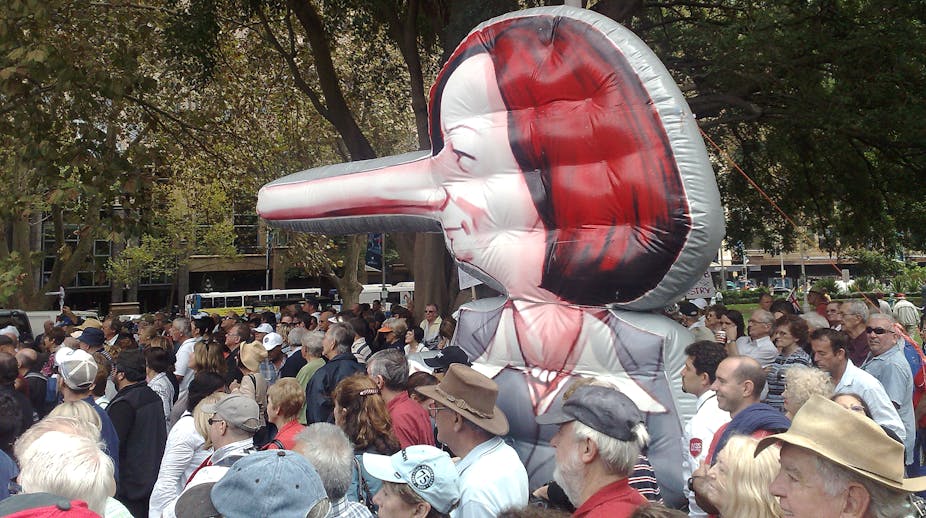In the current vicious political climate, caricatures in our daily press have become more savage. Perhaps no politician has experienced this more in recent times than former prime minister Julia Gillard. Caricatures are by their nature scurrilous and scathing, but some can invite identification with the seductive allure of those who are caricatured.
Australia has inherited a particularly English attitude towards caricature in cartoons, which was founded on press freedom and the rise of a large reading public in 18th century England. English colonists arrived in our region at the height of the caricature boom, the late 1760s and early 1770s, and some of our most celebrated visitors such as Sir Joseph Banks were mocked in this form in their day. But might the socially secure Banks have enjoyed it all nonetheless?
The word “caricature” comes from the Italian for “charged” or “loaded”. A caricature typically makes use of facial or corporeal distortion and dress, props, settings and companion figures frequently set the scene. The geographical origins of the first caricatures lie with Renaissance masters such as Leonardo da Vinci, Giuseppe Arcimboldo and Albrecht Dürer.
Italy specialised in the production of recognisable portrait caricatures throughout the 18th century. These works did not circulate widely in the public realm but were designed for the amusement of aristocratic circles participating in the Grand Tour of France and Italy. Many such images showed young English male visitors drunk and disorderly, and they were a right of passage for the artist, painted as well as turned into prints.
With cheaper forms of reproduction as well as a growing literate audience for periodicals in Enlightenment Europe, there was a marked increase in the output of satirical printmaking from the 1760s in France, Germany and the Dutch Republic, but also notably in England.
England’s press freedom and public involvement in political and cultural affairs encouraged the production of tens of thousands of political and social caricatures. England’s libel laws were rarely invoked, as this would demand an embarrassing appearance in court to rebut the image. No-one has found evidence of a prosecution in 18th century England for publishing a caricature image, no matter how obscene.

Certain political satires and libels were particularly good earners as affronted individuals had to buy up the whole set in order to censor the image and this guaranteed huge profits for the print shops which were gathered around St James’ and the West End. Cruikshank’s receipt for a £100 bribe he took not to caricature King George IV “in any immoral situation” is in the Royal Archive.
Caricature prints were relatively expensive, sought out by the aristocracy, the gentry and even collected by King George III. However, prints were also available for viewing in print-shops, on the walls of taverns, coffee houses, bog-houses and clubs and could be hired in folios, or in the 1790s, visited in exhibitions.
English prints were sent as far as St Petersburg in Russia. Ambassadorial missions reported on their contents to rulers such as Louis XVI as a source of cultural and political information. The Public Advertiser (London) noted in 1765 that:
prints are a universal language, understood by Persons of all…Degrees.
Caricatures did not appear very often in newspapers of the time, as a stamp tax on the paper meant that the images would have taken up too much room.
Caricature prints do not simply “reflect” the world. They had multiple meanings to different audiences and may have helped create the dynamic of an event. Like the 18th century theatre, which assumed different listening positions from its multiple publics, the power of the caricature was to function on many levels simultaneously. It has been argued that some of the scathing images of the Royal Family worked to their advantage as they “humanised” the monarch at a time of potential crisis in the Revolutionary period.
Politicians and other public figures might in fact take pleasure in their own caricatures, vicious as they are, as a sign of true power and status. That Julia Gillard never seemed comfortable in her own skin on the public stage made her a particular target. This was not always about misogyny – the genre attacks all sitters – but rather about her self-confidence as leader.
With his lust for public attention, Kevin Rudd may well revel in the cartoonist’s barb, just as Sarah Sophia Banks, Joseph’s sister and virtuoso collector, noted that this was her own brother, for posterity, next to her personal copy of his caricature.
For politicians, caricatures go hand-in-hand with the job. It seems today’s cartoonists are not about to let up.

